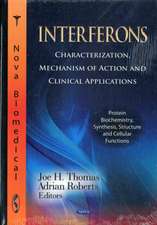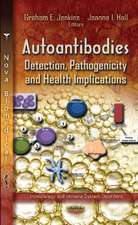The Immune Synapse as a Novel Target for Therapy: Progress in Inflammation Research
Editat de Luis Gracaen Limba Engleză Hardback – 19 oct 2007
Din seria Progress in Inflammation Research
- 5%
 Preț: 1615.04 lei
Preț: 1615.04 lei - 5%
 Preț: 1433.10 lei
Preț: 1433.10 lei - 5%
 Preț: 723.05 lei
Preț: 723.05 lei - 18%
 Preț: 950.21 lei
Preț: 950.21 lei - 15%
 Preț: 648.42 lei
Preț: 648.42 lei - 5%
 Preț: 1300.72 lei
Preț: 1300.72 lei - 5%
 Preț: 1103.95 lei
Preț: 1103.95 lei - 5%
 Preț: 1061.93 lei
Preț: 1061.93 lei - 5%
 Preț: 715.35 lei
Preț: 715.35 lei - 5%
 Preț: 1098.63 lei
Preț: 1098.63 lei - 5%
 Preț: 657.90 lei
Preț: 657.90 lei - 5%
 Preț: 717.93 lei
Preț: 717.93 lei - 5%
 Preț: 996.71 lei
Preț: 996.71 lei - 5%
 Preț: 1413.72 lei
Preț: 1413.72 lei - 5%
 Preț: 1102.46 lei
Preț: 1102.46 lei - 5%
 Preț: 1102.82 lei
Preț: 1102.82 lei - 5%
 Preț: 991.70 lei
Preț: 991.70 lei - 5%
 Preț: 1115.86 lei
Preț: 1115.86 lei - 5%
 Preț: 720.31 lei
Preț: 720.31 lei - 5%
 Preț: 1611.76 lei
Preț: 1611.76 lei - 5%
 Preț: 654.23 lei
Preț: 654.23 lei - 5%
 Preț: 1414.64 lei
Preț: 1414.64 lei - 5%
 Preț: 652.77 lei
Preț: 652.77 lei - 5%
 Preț: 1099.94 lei
Preț: 1099.94 lei - 5%
 Preț: 1856.59 lei
Preț: 1856.59 lei - 15%
 Preț: 644.95 lei
Preț: 644.95 lei - 5%
 Preț: 1108.72 lei
Preț: 1108.72 lei - 5%
 Preț: 658.46 lei
Preț: 658.46 lei - 5%
 Preț: 1108.51 lei
Preț: 1108.51 lei - 24%
 Preț: 801.38 lei
Preț: 801.38 lei - 5%
 Preț: 715.19 lei
Preț: 715.19 lei - 5%
 Preț: 1807.08 lei
Preț: 1807.08 lei - 5%
 Preț: 721.40 lei
Preț: 721.40 lei - 5%
 Preț: 991.70 lei
Preț: 991.70 lei - 5%
 Preț: 720.68 lei
Preț: 720.68 lei - 5%
 Preț: 1100.09 lei
Preț: 1100.09 lei - 15%
 Preț: 577.87 lei
Preț: 577.87 lei - 5%
 Preț: 652.77 lei
Preț: 652.77 lei - 5%
 Preț: 653.35 lei
Preț: 653.35 lei - 5%
 Preț: 650.25 lei
Preț: 650.25 lei - 5%
 Preț: 1116.73 lei
Preț: 1116.73 lei - 5%
 Preț: 1096.98 lei
Preț: 1096.98 lei - 5%
 Preț: 1412.62 lei
Preț: 1412.62 lei - 5%
 Preț: 1420.49 lei
Preț: 1420.49 lei - 5%
 Preț: 721.77 lei
Preț: 721.77 lei - 5%
 Preț: 1102.10 lei
Preț: 1102.10 lei - 5%
 Preț: 1099.20 lei
Preț: 1099.20 lei
Preț: 720.68 lei
Preț vechi: 758.60 lei
-5% Nou
Puncte Express: 1081
Preț estimativ în valută:
137.92€ • 143.81$ • 114.62£
137.92€ • 143.81$ • 114.62£
Carte tipărită la comandă
Livrare economică 20 martie-03 aprilie
Preluare comenzi: 021 569.72.76
Specificații
ISBN-13: 9783764382957
ISBN-10: 3764382953
Pagini: 200
Ilustrații: XII, 192 p.
Dimensiuni: 170 x 244 x 18 mm
Greutate: 0.54 kg
Ediția:2008
Editura: Birkhäuser Basel
Colecția Birkhäuser
Seria Progress in Inflammation Research
Locul publicării:Basel, Switzerland
ISBN-10: 3764382953
Pagini: 200
Ilustrații: XII, 192 p.
Dimensiuni: 170 x 244 x 18 mm
Greutate: 0.54 kg
Ediția:2008
Editura: Birkhäuser Basel
Colecția Birkhäuser
Seria Progress in Inflammation Research
Locul publicării:Basel, Switzerland
Public țintă
Professional/practitionerCuprins
The immune synapse and T cell activation: regulation by chemokines.- The induction of regulatory T cells by targeting the immune synapse.- Infiltrating the immunological synapse: prospects for the use of altered peptide ligands for the treatment of immune pathology.- Targeting CD4 for the induction of dominant tolerance.- Anti-CD3: from T cell depletion to tolerance induction.- Immune modulation by CD40L blockade.- CTLA-4-immunoglobulin and indoleamine 2,3-dioxygenase in dominant tolerance.- Adhesion molecules as therapeutic targets.- E3 ubiquitin ligases and immune tolerance: Targeting the immune synapse from within?.- FOXP3 biochemistry will lead to novel drug approaches for vaccines and diseases that lack suppressor T cells.- Transforming growth factor-?: From its effect in T cell activation to a role in dominant tolerance.- From mice to men: the challenges of developing tolerance-inducing biological drugs for the clinic.
Textul de pe ultima copertă
The immune synapse can be compared to a molecular machine that controls T cell activation when getting in contact with an antigen-presenting cell (APC). The immune synapse is involved in the transfer of information across the T cell–APC junction. It plays an essential role in the control and nature of the immune response.
In recent years several approaches have been developed to reprogram the immune response by targeting molecules involved in the immune synapse. Monoclonal antibodies, such as those targeting the lymphocyte co-receptor, costimulatory and adhesion molecules (CD3, CD4, CD40L, CTLA4-Ig, LFA-1), or altered peptide ligands have been shown capable of inducing immune tolerance in transplantation, autoimmunity and allergy.
This volume discusses the progress in the field, from basic science to clinical trials, and the major mechanisms involved. It is of interest to clinicians and researchers working in this area.
In recent years several approaches have been developed to reprogram the immune response by targeting molecules involved in the immune synapse. Monoclonal antibodies, such as those targeting the lymphocyte co-receptor, costimulatory and adhesion molecules (CD3, CD4, CD40L, CTLA4-Ig, LFA-1), or altered peptide ligands have been shown capable of inducing immune tolerance in transplantation, autoimmunity and allergy.
This volume discusses the progress in the field, from basic science to clinical trials, and the major mechanisms involved. It is of interest to clinicians and researchers working in this area.
Caracteristici
Discusses how interfering with T cell activation may lead to immune tolerance Describes immune modulation and the recruitment of regulatory T cells Provides information on the role of monoclonal antibodies in tolerance induction Describes mechanisms maintaining dominant tolerance Includes supplementary material: sn.pub/extras








